“By a show of hands, how many people pick up their cell phones or check their email within five minutes of waking up?”
In a room full of industry and academic leaders, about three-quarters of the hands went up. Some people even instinctively reached for their phones.
Matt Kempler, a director of digital innovation at Ansell, the world’s largest provider of protective clothing solutions for industry, went on to say that nearly all individuals who use digital technology look at their smartphones within 25 minutes of waking up, studies show.
And in addition to being online via phones and laptops, there is of course the explosion of the Internet of Things (IoT). Slick new wearables abound, including fitness trackers, wearable cameras, smart watches, and heart rate monitors. The level of connectivity this all represents is eye-opening.
How are businesses making the most of this increasingly seamless world? What new approaches are possible?
At the Mack Institute’s Fall Conference 2016, leaders in health care, telecommunications, data analytics, manufacturing, and other industries discussed their company’s progress toward a “connected strategy.” Rather than having episodic or occasional interactions with customers, firms are trying to engage with them in a continuous loop, using technology to provide products and services as needs arise. The implications for business are profound.
Big Pharma and the Customer Experience
Robert Boland, associate director for Emerging Science and Innovation Strategy at Johnson & Johnson, discussed connected strategy through the lens of the customer experience. He quipped that he works on “the kinds of things you’d see in Omni Magazine.” These areas included epigenetics and multi-omics: going beyond finding genetic biomarkers of diseases to analyzing how a person’s environment affects their health.
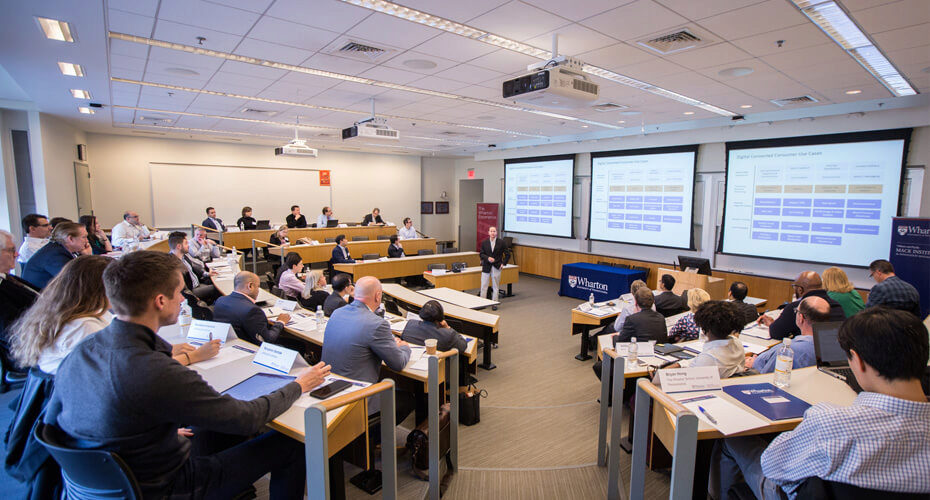
Big Pharma is increasingly connected with customers directly, he said, through innovations such as web and mobile devices, sensors, digital diagnostics, and behavior tracking. One of many examples he cited is the development of “smart” digital drug packaging to keep people on their medication schedules. “You could actually monitor, in effect, if someone’s taking too much of a medicine, or too little of a medicine — whatever their regimen should be,” he said.
On the subject of preventing disease relapses, Boland described an intriguing J&J trial called Project Starlight in which multiple wearable technologies were used to continuously monitor patients with schizophrenia. J&J biostaticians built algorithms around the physical and social changes that preceded patients’ relapses, which could yield valuable keys to managing the disorder.
Boland also discussed J&J’s Consumer Experience Center, at which individuals spend time doing live trials with products. “There’s end-to-end innovation, a holistic approach to really connecting with the customer,” he said.
A Sea Change in Sales and Marketing
“I came here from the Midwest, where I had access to my electronic health records. I moved to the East Coast: no access,” said Stephen Ranjan, an executive director for Priority Customer Solutions at Merck.
 For Ranjan, this personal experience encapsulates how healthcare is lagging behind the digital connectivity we expect today.
For Ranjan, this personal experience encapsulates how healthcare is lagging behind the digital connectivity we expect today.
“Fundamentally we’re challenged with this: the technology exists, but the experience for a consumer does not match what you experience in other areas.” He pointed to regulatory and privacy roadblocks, among others.
He posed the question, “How do you advance the customer experience so it’s much more seamless?”
Ranjan described how sales and marketing — his bailiwick at Merck — is moving away from just creating marketing collateral for the customer. Multiple stakeholders also are looking at the consumer now, he asserted: the health system, the payer, the government. For example, some health systems are providing consumers with electronic medical records (even if not fully rolled out, as he stated), and with digital ways to get in touch with your care team immediately when you feel ill.
On the insurance side, he cited Aetna’s recent announcement that it plans to work with Apple to display people’s co-pays and deductibles on their smart phones. “So transparency is starting to become an interesting factor,” he noted.
Ranjan said that “what keeps him awake at night” is the speed at which technology startups and pharma’s customers are changing and developing. He said that at Merck, he and his colleagues are exploring novel partnership with payers and providers, especially those that are innovators and early adopters.
New Business Models in B2B
“Digital is disrupting the traditional B2B market” was the main message from Ansell’s Matt Kempler.
“We’ve been around for 120 years,” said Kempler, “which means we have 120 years of history to go from an old-school way or more traditional way of thinking about how you connect your enterprise to a more progressive way.” The company, he said, is “quite nascent” in its move toward digital.
One major trend sparking the transformation is that Ansell’s distributors are moving increasingly toward online sales. Kempler said that channel is growing 25% year over year. Moreover, he quoted research that 87% of B2B buyers believe that online content has a major or moderate impact on vendor selection. Ansell needs to partner and integrate with these companies: “We want to either be the disruptor or we’re going to be disrupted,” he stated.
Kempler’s colleague Andy Lin, a senior director in the digital innovation group and global IT, then presented an example of the company’s customer-centric efforts: a program called Ansell Guardian. “This is a unique suite of management tools that help our customers improve safety, efficiency and productivity while reducing costs,” he said.
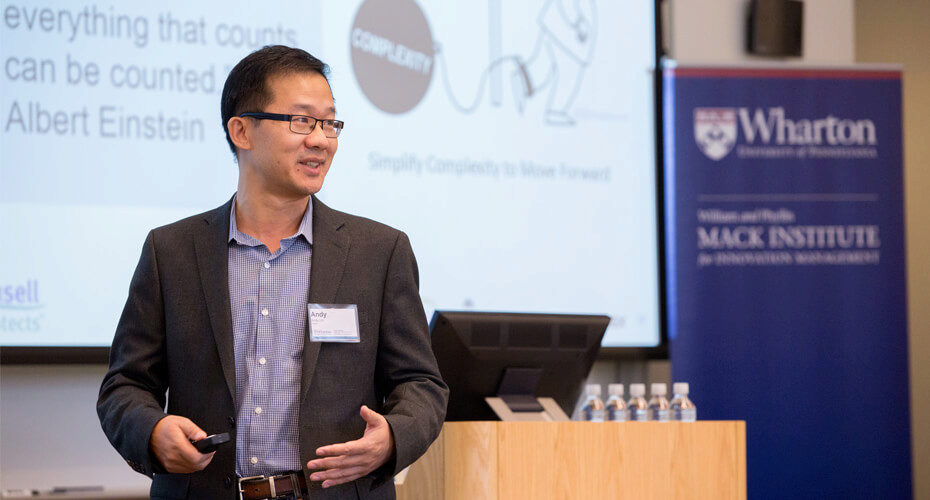
With Ansell Guardian, the company partners with distributors to solve the end user’s safety and productivity challenges, yielding immediately-actionable business performance improvements. Lin cited an example of a large North American industrial corporation who was experiencing high rates of hand lacerations. During just the first year following the best practice implementation, Ansell Guardian Industrial was able to achieve first aid injury reduction by 90% with zero recordable injuries.
Overall, said Kempler, “we’re thinking about the customer journey, and thinking about digitizing it to make that journey easier.”
Digital Connectivity in Health Care
Christian Terwiesch, co-director of the Mack Institute and a Wharton professor of Operations, Information and Decisions, recently discovered that more customer connectivity in healthcare is not always a good thing.
A research study of primary care visits led him to conclude that “the doctor’s on the keyboard” for a good portion of the time and that there’s much more talking than physically touching the patient. “It has become very much like an administrative task.” Given that information, he posited, could primary care visits be accomplished mostly remotely through the Internet, Skype, patient portals, or messaging to save healthcare costs and resources?
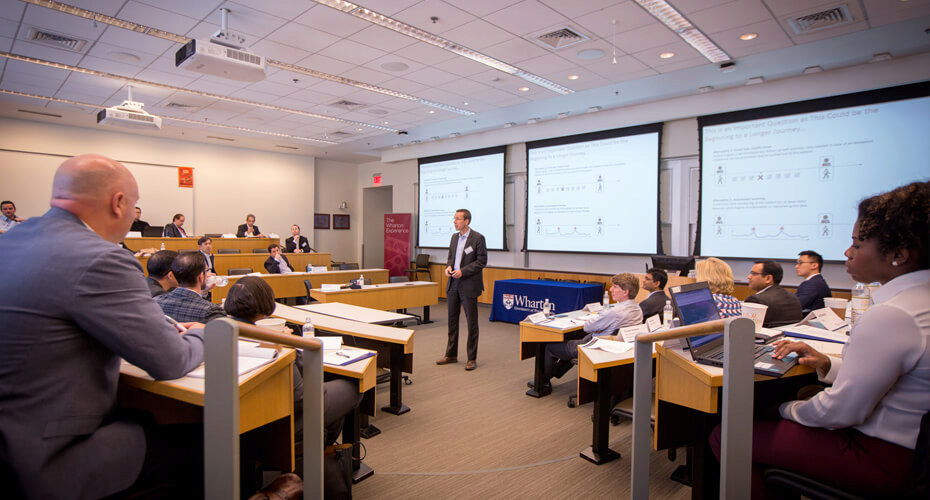
Some patient portals already exist in the United States. Patients can communicate with their care team, ask non-urgent medical questions, view test results, schedule procedures, and more. The promise of virtual health care like this is that you won’t need to see your doctor as often, said Terwiesch.
However, when Terwiesch and his colleagues studied one such portal, the MyPennMedicine system at the University of Pennsylvania, they found the opposite. “People who are sick, the people who consume 80% of the care resources” were contacting their doctors more often to complain of symptoms, which led to even more in-person appointments. And overall, the patients in the study did not necessarily get healthier.
Terwiesch pointed out that in this type of situation, the choice of business model is key. If profits are based on pay for services, this scenario is theoretically fine, because more services are being generated. “But in terms of pay for value, it’s a disaster,” because it leads to the “over-consuming of a scarce resource”: the provision of healthcare.
Brainstorming Connected Strategy Business Models
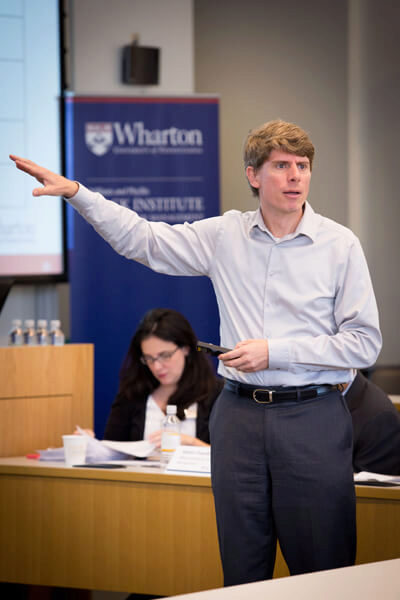 Nicolaj Siggelkow, Mack Institute co-director and a Wharton professor of management, reflected on the morning’s presentations. Companies are moving, he said, “from a few episodic interactions to firms reacting back, connecting back to customers in a much more continuous way.” Among the industries he named were health care, software, transportation, and education.
Nicolaj Siggelkow, Mack Institute co-director and a Wharton professor of management, reflected on the morning’s presentations. Companies are moving, he said, “from a few episodic interactions to firms reacting back, connecting back to customers in a much more continuous way.” Among the industries he named were health care, software, transportation, and education.
He emphasized the importance of good business models, saying that while they hinge on technological progress, the technology on its own is not enough. For example, “Uber didn’t develop Google Maps. They used Google Maps to build a business model around it.”
He identified some examples of innovative operating models. The “Single Connect” model replaces one interaction with several: for example, a purchase of a Nike or UnderArmour product is linked with a digital fitness program. In the “Retailer” model, a firm like Amazon, Netflix, or Pandora connects suppliers with customers while still handling the product. And in the “Person to Person Network Creator,” companies like Facebook and Venmo connect individuals with each other and are supported by advertising or by a parent company.
Siggelkow charged the attendees with working in groups to come up with new business models for assigned industries. Some intriguing ideas emerged.
From the insurance group, Dee Slattery, a senior director of global brand marketing at Ansell, reported on the idea of a smart car that was connected to the driver’s insurance provider and health care provider via a wearable. If the driver is in an accident or has a heart attack on the road, the information is relayed seamlessly. “Your experience of driving and car insurance becomes more intimate and personalized,” she noted.
Reporting for the entertainment group was Lemu Coker, a partnerships lead for open innovation at Verizon. He presented the idea of location-based and personalized services based on the data that consumers’ smart phones automatically generate about them, noting that the entertainment industry could leverage this for new business models.
Coker also talked about the expansion of entertainment companies like Netflix into different business models: from online curator, to content creator, to seller of that content to network television. An important competitive factor for firms to consider is user experience: “When the movies are the same, how do you present them to people in ways that are easier to take in?”
The View from Tech
The burgeoning new area of connected strategy poses some interesting challenges and opportunities for technology: the telecommunications infrastructure, IoT, artificial intelligence. What’s on the horizon?
In telecommunications, Aileen Smith, the head of ecosystems for Huawei Technologies, described a revolutionary concept called network slicing. Different types of connections would be tailored to different types of traffic, thus providing improved service while saving costs and resources.
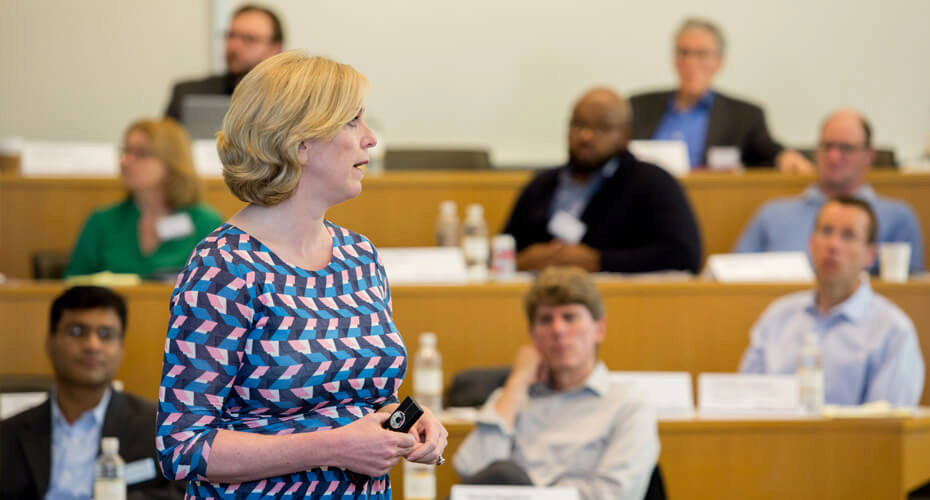
“Today, when you make a call on your smartphone, it runs on a 3G or 4G connection,” she noted. “If your phone is also monitoring the number of steps you’ve taken, it’s also using that kind of connection. That’s actually quite wasteful because you’re using a big, expensive network capability to transfer data that’s quite small.”
Smith described a potential world in which industries and products such as healthcare, finance, robotics, smart utility meters, and self-driving cars will each have network slices optimized for their activities. “In 5G technology, everything in the network will effectively be software running on commodity hardware. You could in theory create a virtualized network slice with specific parameters.”
When — and if — this capability is achieved, said Smith, “it will be very powerful for the emergence of a lot of applications in the future.”
* * * * * *
The CTO of Verizon Telematics, Pramod Kalyanasundaram, discussed connected strategy for the Internet of Things. He characterized the current state of the industry as being fragmented, with a plethora of devices, platforms, and applications entering the market with siloed user experiences and services.

“IoT has a huge fragmentation problem,” he said, asserting that the problem pervades the application, device, and platform levels. “If you want to buy a thermostat, there are 17 different thermostats you can pick, each works differently and everybody has an app.” He compared the situation to trying to figure out the shower in a foreign hotel, to laughs of recognition from the audience.
The user experience is inconsistent, Kalyanasundaram said, and it’s only getting worse as new devices proliferate. In his view, companies are prioritizing tactics over strategy, causing a lack of holistic solutions. He advocated instead for building new platforms and frameworks with opportunities for other companies to build applications on top using open Application Programming Interfaces (APIs). Another path forward would be putting increasingly sophisticated artificial intelligence in the user interface.
“It’s hard to train six billion people on 100,000 things,” he said. “It is easier to train the system to [adapt] so that it personalizes over time.”
* * * * * *
Julian Jenkins, a vice president for Innovation Performance and Technology at GlaxoSmithKline, talked about how connected health care technology is helping resolve the classic conundrums of running clinical trials.
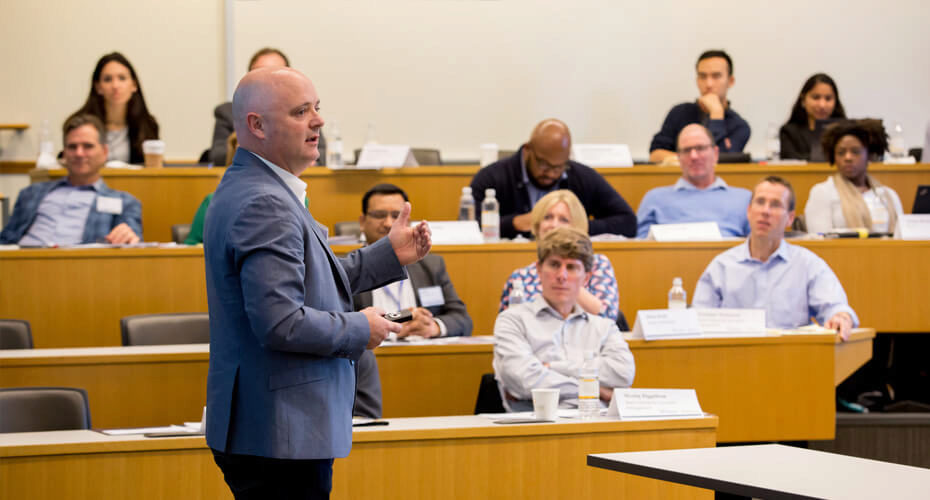
For one thing, faster data analytics means that participant feedback from a clinical trial can be assessed much more speedily. The old way, he said, was “if a drug didn’t work, you didn’t know it until the end. Now we’re moving toward almost universal feedback, in approximately real time.”
Analyzing data sooner also means reducing the need for protocol amendments, a term which refers to having to change the trial’s direction mid-stream. This leads to big cost savings: currently, said Jenkins, more than half of all protocols need to be changed along the way, at a cost of about a half million dollars each.
Recruiting for clinical trials is also undergoing a digital sea change. “Recruitment is a big issue: less than 10% of people with diseases, even serious diseases, participate in clinical research,” Jenkins noted. But recently, his team used social media and Apple’s ResearchKit (a software framework for apps that helps medical researchers gather data) to recruit 400 qualifying participants across five states for a rheumatoid arthritis study, in record time.
* * * * * *

On the subject of business analytics, Mo Patel called today’s analytics “static, reactive, siloed, and opaque.” Patel is a practice director of Artificial Intelligence & Machine Learning at Teradata Analytics. “If you’re a manager and you get a report, typically it’s for data that was from last month. You’re [just] looking in the rear-view mirror.”
But many forces are driving analytic innovation, he said. These include rapid technology adoption in areas from the Internet to automobiles; the huge growth in IoT; and the fact that people increasingly demand the same level of sophisticated analytics at work that they get at home: that is, “Google-type results.”
The analytic needs of the connected consumer are real-time, social, emotional, and immersive, said Patel. He said the way to address those needs is through artificial intelligence. Once machines are able to detect patterns in data to make future predictions, this could enable advances like a digital in-car driving coach; a wearable that advises you about healthy behaviors; a real-time shopping assistant, or a smart home assistant that could predict the cost of your utilities. “We are making huge steps in this area,” Patel said.
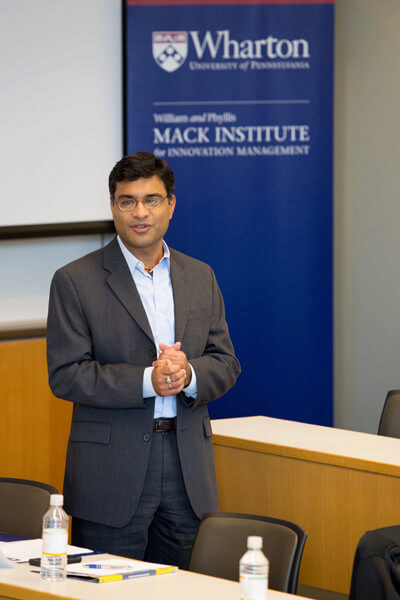 Mack Institute executive director Saikat Chaudhuri closed the conference by praising the “energy, interest, and active dialogue” of the participants. He also noted how the conference reflected the value of engaging in discourse with leaders from other industries.
Mack Institute executive director Saikat Chaudhuri closed the conference by praising the “energy, interest, and active dialogue” of the participants. He also noted how the conference reflected the value of engaging in discourse with leaders from other industries.
“What struck me — and some of us co-directors here as well — is the commonality of the underlying issues and challenges, and also the opportunities, across these presentations. It underscores the importance of this kind of interdisciplinary, cross-industry learning.”
Chaudhuri announced two upcoming Mack Institute conferences: the Blockchain Opportunity Summit on December 6, 2016 in New York City, and the Mack Institute Spring Conference, slated for early June 2017 in San Francisco.




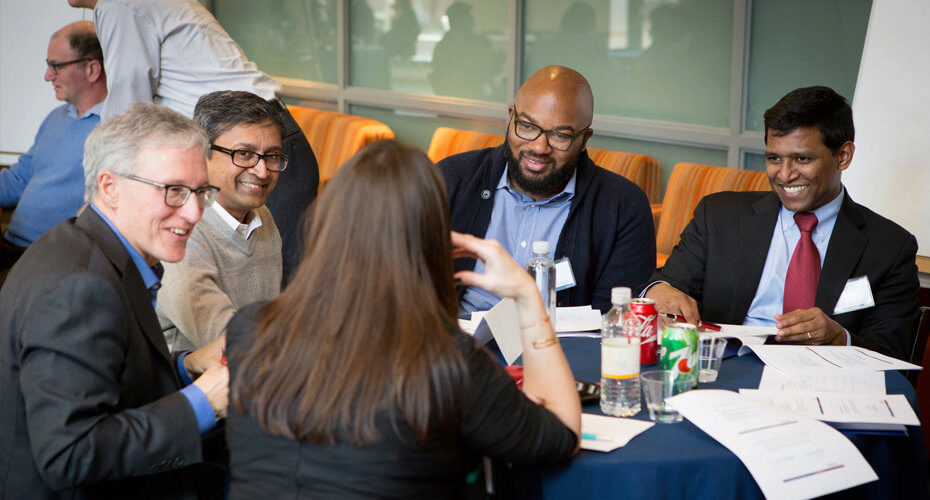

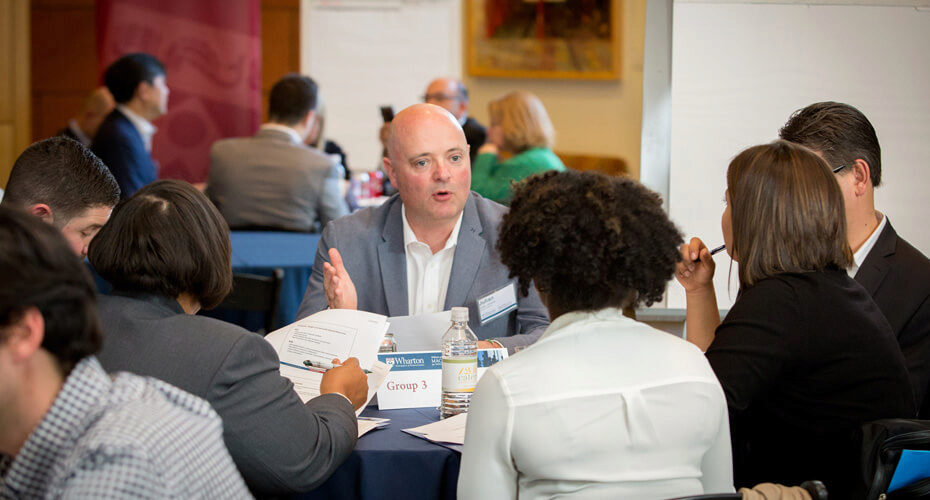


Thanks for this post. I would like to comment in relation to Network Slicing which was brought up by Aileen Smith. 5G is the next step in wireless telecommunications standards. Through the evolution of communications technologies and the advancement of mobile devices such as smartphones and tablets, communications networks need to be both ultra-reliable and flexible so as to adequately meet the needs of applications and data transfer requirements.